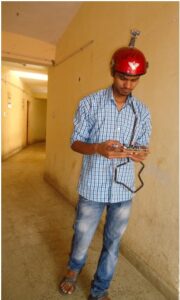In this post, I am giving an idea for an electronic project. The name of this electronic project is “Ultrasonic Haptic Vision System Design for Blinds”.
Where I can use this electronic project??
If you are an electronic circuit lover then you will love this project. But if you are a student you can design and use this project in minor or major projects. This project is a great idea for a BTech or MTech project dissertation. A complete project report will be also provided on-demand with source code. You can use this project for rehabilitation research purposes also.
What skills you need for designing this electronic project??
You must know about the basics of microcontroller and the circuit assembling printed circuit board (PCB) which are not the big deal for you.
The objective of this project is to design a simple, easy to model, microcontroller-based circuit to enable navigation through hallways blindfold.
What is a Haptic Vision??
Haptic Technology refers to technology that interfaces the user with a virtual environment via the sense of touch by applying forces, vibrations, and/or motions to the user. This mechanical stimulation may be used to assist in the creation of virtual objects (objects existing only in a computer simulation), for control of such virtual objects, and to enhance the remote control of machines and devices (teleoperators). [1]
Designing the Hardware
In this article, I am providing hardware, named Ultrasonic Haptic Vision System which will provide an ability to travel around unknown places to Visual impairment or blind persons through user-friendly interfaces.

The controller used is a low power, cost-efficient chip manufactured by ATMEL having 1Kb of data RAM and 64 kb on-chip flash memory. It communicates with the various modules in real-time in order to control the movement of the sensor in the mechanical structure.
A Graphic User Interface with Visual Basic Application is also used for real-time display of data acquired from the sensor. All the components which are used in this project, easily available. this will reduce the making cost and also the maintenance cost.
the code is quite flexible you can change this any time according to your need. This is making the project tailor-made. We can add any specific kind of requirements for yhe user.
Above feature will make this hardware an economical, portable, and a low maintenance solution for moblie applications, especially in industrial areas.
 List of Hardwares:
List of Hardwares:
HC SR 04 – ULTRASONIC RANGE SENSOR
8051 MCU
L298HN – FULL BRIDGE
SERVO MOTOR
ULN2803 – DARLINGTON ARRAY
RF CIRCUIT: TRANSMITTER AND RECEIVER
Voltage Regulator (KA 7805)
MAX 232
A serial port of computer
CONCLUSIONS:
The last plan met and surpassed the entirety of the desires that were spread out before beginning to development of this undertaking. The entire objective was to have the option to explore a foyer effectively without running into any dividers while blindfolded as a showing that this thought was natural and achievable. Next time, notwithstanding any budgetary requirements we would have appended motors all around the cap so as to get however much tangible information through haptic input as could reasonably be expected with around 8 vibrating motors.
Additionally, the pivoting ultrasonic sensor on the motors mounted on the cap is bothersome on the grounds that it is best not to have a fragile turning segment for wellbeing and tasteful concerns. Two answers for this is have various sensors for every one of the 8 vibrating motors which would empower them to be refreshed at 20Hz and subsequently a more successful channel could be utilized as a result of the quick estimations.
Another alternative is have one ultrasonic transmitter that communicates radially, with 8 ultrasonic sensors that read the contribution from the transmitter to decide separations, however this choice would have included substantially more equipment since we would have needed to produce the range an incentive from the ultrasonic sensor ourselves rather than utilizing the sensor to do the entirety of the translation for you.
Credits for this article:
Assistive Technology Blog for the cover image and my students
HARISH CHANDRA, SACHIN KUMAR and PRAHLAD SINGH.
If you need any kind of help feel free and write to me.
0 Comments